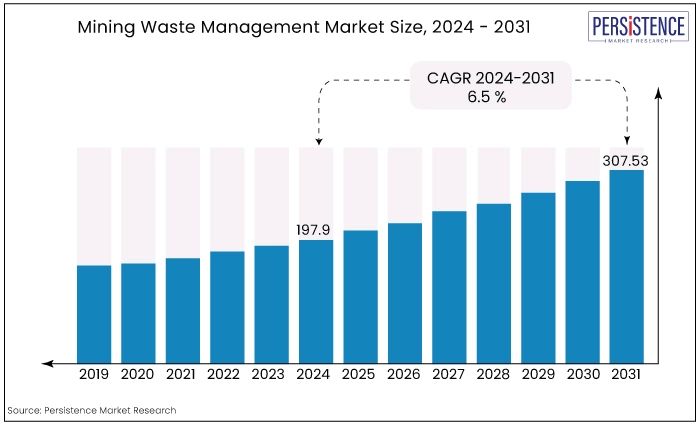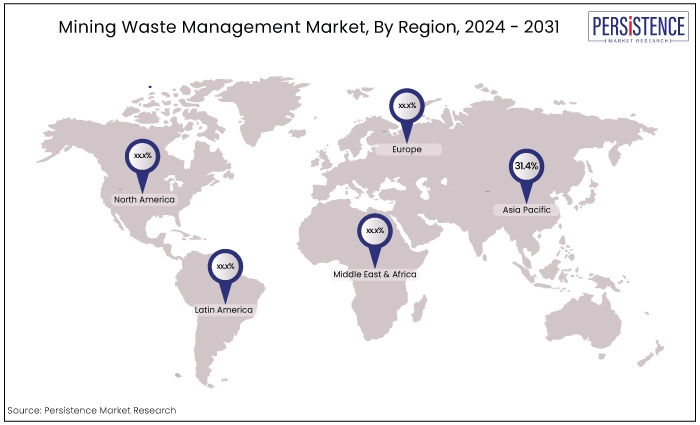Industry: Energy & Utilities
Format: PPT*, PDF, EXCEL
Delivery Timelines: Contact Sales
Report Type: Ongoing
Report ID: PMRREP34632
The global market for mining waste management is estimated to value at US$307.53 Bn by the end of 2031 from US$197.9 Bn recorded in 2024. The market is expected to secure a CAGR of 6.5% in the forthcoming years from 2024 to 2031.
Key Highlights of the Market
|
Market Attributes |
Key Insights |
|
Market Size (2024E) |
US$197.9 Bn |
|
Projected Market Value (2031F) |
US$307.53 Bn |
|
Forecast Growth Rate (CAGR 2024 to 2031) |
6.5 % |
|
Historical Growth Rate (CAGR 2019 to 2024) |
6.1 % |
The mining waste management market addresses the critical need to responsibly handle and mitigate the environmental impact of mining operations. Mining activities generate substantial waste, including tailings, waste rock, and water, which can pose significant environmental and health risks if not managed effectively.
The market focuses on implementing strategies and technologies to minimize these risks and maximize resource recovery. Key objectives include ensuring regulatory compliance, reducing environmental footprint, and enhancing sustainability practices within the mining sector.
Companies in this market offer services such as waste disposal, remediation, recycling, and environmental consulting to support mining companies in achieving efficient waste management solutions while adhering to stringent environmental standards and community expectations.
The mining waste management market include advanced technologies for tailings management and treatment, such as dry stack tailings and paste backfill systems.
Recycling and reprocessing of mining waste for resource recovery are gaining traction to minimize environmental impact. Integration of digital technologies for real-time monitoring and predictive analytics improves operational efficiency and risk management.
Sustainability-driven approaches, including circular economy principles and carbon footprint reduction strategies, are becoming central to waste management practices. These market trends aim to enhance environmental stewardship, regulatory compliance, and overall sustainability in the mining industry.

The mining waste management market has evolved significantly, driven by increasing regulatory scrutiny and environmental concerns surrounding mining operations globally.
Historically, the market has focused on improving waste handling practices, including the safe disposal of tailings and the management of mine water and waste rock.
Innovations in technology and sustainability have reshaped approaches, emphasizing solutions that reduce environmental impact and enhance resource recovery.
The market is poised for continued growth as mining companies prioritize sustainable practices and compliance with stringent regulations. Future developments will likely include advancements in waste treatment technologies, increased adoption of recycling and reuse strategies, and enhanced monitoring and reporting capabilities.
The efforts aim to not only minimize environmental risks but also improve operational efficiency and community relations, ensuring responsible mining practices for a more sustainable future.
High Level of Concern for Environmental Safety
The expansion of the sector is being accelerated by processors' growing environmental conscience. The growing global population has led to a sharp rise in the demand for various metals and minerals, which has accelerated mining activities.
Consequently, there is a growing need for mining waste management techniques to lessen the negative environmental effects. The ethical acquisition of these metals and sustainable recycling are encouraged by the management of mining waste.
Popularity of Surface Mining Method
Over the course of the forecast period, the surface mining method is expected to dominate the mining waste management market. Surface mining is more cost-effective, safer, and has a higher pace of exploration than underground mining.
Surface mining methods are used to recover minerals and metals such as coal, iron, gold, nickel, zinc, and others. The growing use of these metals and minerals in various end-use industries will propel the worldwide surface mining business.
The market for mining waste management will expand at a faster rate due to the growing need for metals and minerals across a range of industries and the world's ongoing industrialization.
Growth in market value will also be fueled by the growing requirement for efficient waste management after deepwater and ultra-deepwater oil mining and extraction operations. Additional factors predicted to support market growth include the rise of the automotive sector and the rise in defense spending.
Furthermore, the growing popularity of electric vehicles (EVs) contributes to growth because EVs require complex concentrations of metals, such cobalt, nickel, and lithium, which are often obtained through mining operations.
Environmental Considerations
Environmental factors that should be largely considered before the waste management process include the danger that harmful dusting poses to wildlife and vegetation, as well as pollution of water and soil, gas emissions, and land usage.
Moreover, potential risk from unusual weather phenomena (such as liquefaction, and landslides), the effects of urban mining, and the use of chemicals and garbage also ought to be considered.
Dearth of Efficient Waste Management Practices
Most of mining waste-related environmental degradation is a result of inadequate leaching and acid mine drainage control methods. Leachates from mine waste overburden dumps have the potential to affect neighboring water sources.
Despite a variety of recycling methods, most of mine waste is kept in facilities. The long-term storage of the mining assets has become a critical concern with modern mine closures. This would therefore pose a barrier to the market growth rate for mining waste management.
Elevated Metal Production and Exploration
During the forecast period from 2024 to 2031, market players in the mining waste management sector will benefit from expanded opportunities driven by increased production and exploration activities in metals and minerals.
The rise in mineral and metal exploration and production necessitates effective management of mining waste to mitigate environmental impact and adhere to regulatory requirements.
Companies in this market will focus on developing innovative waste management solutions, including advanced tailings management technologies and sustainable recycling practices.
These efforts aim to optimize resource recovery, minimize waste generation, and enhance overall operational efficiency, thereby supporting responsible mining practices and sustainability objectives in the global mining industry.
Acceptance of Cutting-Edge Co-Disposal Methods
The co-disposal approach is being used by numerous companies to efficiently handle mining waste and open up market prospects. With this procedure, waste boulders and fine tailings are blended and disposed away at the same time.
The process aids in maintaining the best possible refinement and the physical and chemical stability of the mining wastes. Co-disposal systems provide many benefits when compared to traditional disposal methods.
|
Category |
Projected CAGR through 2031 |
|
Mining Method - Surface Mining |
5.9% |
|
Waste Type – Overburden/Waste Rock |
5.2% |
Surface Mining Dominant Throughout the Forecast Period
In 2024, the surface mining segment emerged as the largest contributor to market share in the mining industry. This segment encompasses various methods such as open-pit mining, mountaintop removal, and strip mining.
Unlike underground mining, surface mining operations generate significant quantities of waste materials.
Open-pit mining involves excavating large quantities of soil and rock to access mineral deposits near the surface. Mountaintop removal mining alters entire landscapes by removing mountaintops to extract coal and other minerals, leading to substantial waste accumulation.
Strip mining involves the removal of overburden to expose mineral seams, resulting in extensive waste production from the displaced materials.
The dominance of surface mining reflects its efficiency in accessing shallow mineral deposits and supporting high-volume production.
However, effective management of mining waste from these operations is crucial to minimize environmental impact and comply with regulatory standards, driving innovation in waste management technologies and practices in the mining sector.
Overburden/Waste Rock Commands the Largest Market Share
In 2024, the Overburden/Waste Rock segment dominated the mining waste management market. This segment is categorized into waste rock, tailings, and other waste types.
Among these, the waste rock sub-segment held the largest share, followed by tailings. The generation of waste rock is influenced by factors such as mine geometry, mining method, composition, and stripping ratio.
Waste rock is produced during the excavation process to access ore bodies, making it a significant component of mining waste.
Efficient management of waste rock is crucial for minimizing environmental impact and maintaining compliance with regulatory standards, highlighting the importance of advanced waste management solutions in the mining industry.
|
Region |
CAGR through 2031 |
|
Asia Pacific |
31.4% |
The Asia Pacific to Account for the Significant Share in the Mining Waste Management Market
Asia-Pacific maintains dominance in market share and revenue in the forecast period from 2024 to 2031, driven by robust demand for minerals and metals.
The region's leadership is bolstered by the expansion of key industries including electrical, automotive, construction, power, and energy. This growth fuels the need for effective mining waste management solutions to sustain resource supply chains and meet stringent environmental regulations.
The high demand for raw materials in sectors like automotive, and construction underscores the critical role of efficient waste management practices in maintaining operational sustainability.
As Asia Pacific continues to lead in industrial production and infrastructure development, advancements in mining waste management technologies will be pivotal in optimizing resource utilization and minimizing environmental impact.
Strategic investments in innovative solutions for tailings management and recycling are crucial to supporting sustainable growth across these vital economic sectors in the region.

The mining waste management market on a global scale is dominated by several well-known companies, many of whom are anticipated to hold significant market share in the next years.
Leading companies in the mining waste management industry worldwide may also partner with smaller companies to enhance their market share and market presence.
To support their long-term growth, the smaller competitors in the mining waste management sector will also look to raise capital from other private and public investors.
Recent Industry Developments
June 2024, Veolia Environment S.A. announced a strategic partnership with Rio Tinto to develop advanced waste management solutions for Rio Tinto’s mining operations. This collaboration aims to enhance resource recovery and implement sustainable waste disposal practices.
May 2024, SUEZ Launches New Tailings Management Technology SUEZ introduced a cutting-edge tailings management technology designed to reduce environmental impact and improve the efficiency of mining operations. This new solution is expected to set a benchmark in the industry for sustainable waste management practices.
March 2024, Tetra Tech, Inc. announced a collaboration with BHP to enhance tailings dam monitoring and management. This initiative aims to leverage Tetra Tech’s advanced geotechnical engineering solutions to ensure the safety and sustainability of BHP’s mining operations
|
Attributes |
Details |
|
Forecast Period |
2024 to 2031 |
|
Historical Data Available for |
2018 to 2023 |
|
Market Analysis |
US$ Million for Value |
|
Key Regions Covered |
|
|
Key Market Segments Covered |
|
|
Key Companies Profiled in the Report |
|
|
Report Coverage |
|
|
Customization & Pricing |
Available upon request |
By Mining Method
By Mineral/Metal
By Waste Type
By Region
To know more about delivery timeline for this report Contact Sales

The increasing focus on environmental sustainability, regulatory compliance, and efficient resource utilization is driving the demand for effective mining waste management solutions globally.
Some of the key players operating in the market are Veolia Environment S.A., Clean Earth, Inc., SUEZ S.A., Waste Management, Inc., and Tetra Tech, Inc.
The surface mining segment recorded the significant market share.
A compelling opportunity in the mining waste management market lies in developing advanced technologies for tailings management and resource recovery, meeting the growing demand for sustainable practices amid increasing mineral exploration and production activities globally.
Asia Pacific to account for the significant share in the market.